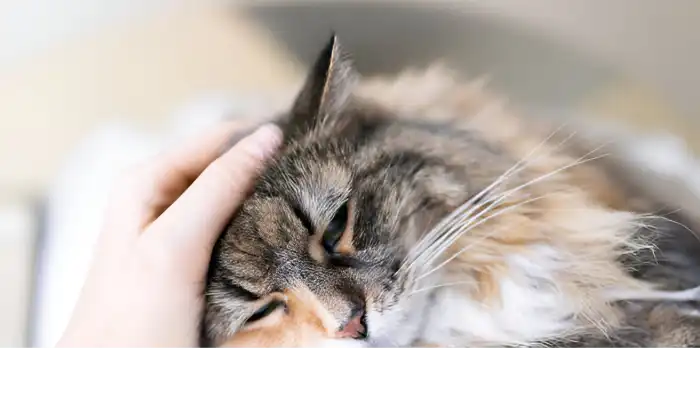How do cats say “no”? Cats do not use speech to convey their emotions, but they surely do show their disagreements towards something in various ways. A cat expresses itself and its feelings through body movements, sounds, or actions.
These signals are very important for every cat owner intending to have a good relationship with their cats. In this article, we will look at how cats express disagreement, what these behaviors mean, and how a cat translator can help interpret them, along with the best ways to respond.

How Do Cats Show Rejection?
How do cats say “no”? Cats possess different techniques to express when they do not want something. Although they do not speak in words, their body movements, sounds, and actions clearly show how they feel. Here are some common ways cats say “no”:
- Body Movements: Shifting away from the target, tail stiffness, or ear folding.
- Sound Production: Hisses, growls, and aggressive or high-pitched meows.
- Actions: They may swat, leave the area, or hide away.
Cat Signals That Mean “No”
| Behavior | Meaning |
|---|---|
| Tail flicking | Annoyance or irritation |
| Flattened ears | Warning sign, feeling threatened |
| Hissing/growling | Strong rejection, distress |
| Swatting | Defensive action, wants space |
| Walking away | Silent refusal, disinterest |
Recognizing these signals will help you respect your cat’s boundaries and avoid unnecessary stress.
Body Language Signs That Mean “No”
Cats communicate with each other through body language. How do cats say “no”? Here are some key signs that indicate their refusal:
1. Tail Movements
- Quick flicking tail: Annoyance or mild irritation.
- Puffed-up tail: Strong rejection, fear or aggression.
- Tucking the tail under the body: Discomfort or insecurity.
2. Ear and Toe Signals
- Flattened ears: A clear sign of stress, warning you to back off.
- Narrowed Eyes or Dilation: Shows unwillingness to engage or display unease.
- Avoiding eye contact: Your cat is ignoring you as a form of refusal.
3. Posture And Movement
- Turning away or walking off: Silent but authoritative refusal.
- Lying down with swishing tail: Agitation so just leave them be.
- Arching the back: An indication of defensive posture means elements are not at ease.
This is how you can tell that your feline friend doesn’t want to be bothered at that moment by examining these signals.
How Cats Say ‘No’ with Sounds
Even though not every cat yells, those that do are usually able to refuse in a way that can be understood very easily. How do cats say “no”? Here’s how different sounds from them indicate “no”:
1. Hissing and Growling
- This type of vocal rejection is the strongest and suggests that the cat perceives danger.
- Immediate action: Leave them alone!
2. Short, Sharp Meows
- This is a form of protest, typically indicating the cat is unhappy with the current situation.
- Example: A sudden ‘meow’ when being picked up when they do not expect it.
3. Low-Pitched Meows or Yowls
- Displeasure, discomfort, or pain.
- Example: Sustained yowling before a trip to the vet or during unavoidable engagements with the vet.
Recognizing these calls helps reduce stress in the cat while also building a healthier relationship with the pet.
Things Cats Refuse to Do
How do cats say “no”? The feline species as a whole has a universal way to express ‘no‘ through body language. These are the most common reasons they dismiss or refuse the requests presented to them:”
- Scratched in a designated area they do not appreciate → Behavior: Tail flicking, walking away.
- While being picked up, the cat notices it’s forced to be grabbed → Behavior: Muffing, quite low grumbling, swatting.
- Taking food they object to (analytics/facial response), observing taking food → Behavior: Looking away, absconding, sniffing, and rejecting it.
- Putting a pet animal inside of a carrier (Turns Cat Negative) Forced into a Carrier: → Behavior: Backing away, hiding, and yowling.
- Different pet moving into the zone, whereby the cat lives(fills in the pet’s territory) → Shift in physiology: hostile attitude (hissing, puffing, avoiding the new pet).
By knowing these methods, one tries to reduce disagreements and also helps in addressing the wants and likes of the feline.
Respecting a Cat’s Space and Signals
When it comes to communication, being on the receiving end of your cat’s signals and respecting them helps in building trust and lowers stress levels. Here is what you can do when your cat says “no” to you:
- Pay attention to the signals they are giving you – Observe their movements, as well as sounds they might make.
- Give space when needed – If they do not want to interact, leave them alone.
- Use positive reinforcement – Favorable elements should be praised instead of forcing them into engagements.
- Lower the stress levels in the surrounding area – Your cat should be placed in an area where they feel safe and at ease.
- Never punish them – Cats need a lot more patience than overexposure to disdain.
Key Tip: If there are any signs of irritability within the cat, there are likely stress factors present within the environment or it might be underlying uncomfortableness or even illness.
Conclusion
How do cats say “no”? Pet owners can appreciate how their cats behave and how to combine the signals they get from their homes, with raised boundaries that allow them to respect the limits given by their pets.
The combination of turning the head away, tail motion, meowing, or even sharp walking indicates displeasure, gives clarity on what cats do not want. Pet owners who learn these signals are better positioned to own a trusting feline friend. Understanding when your cat is saying “no” will lead to a more stress-free environment.
